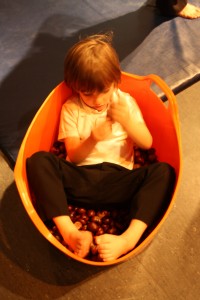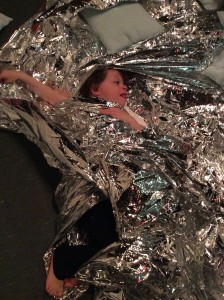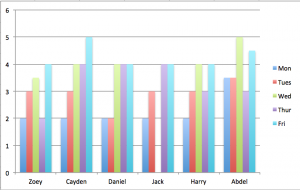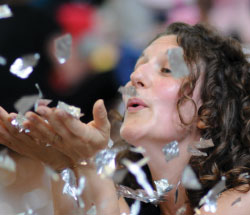
I danced everyday with a class of eight children from Acorns class from Ellesmere College in Leicester and their teaching team. Everyday we went into a studio room, a beautiful blank canvas, with nothing in it except us, a couple of cameras, some post it notes and music. All eight children from Acorns class are on the autistic spectrum and they all started school in September.
Monday: Day One:
We sing hello
There’s music (polka’s, jig’s, a bit of Penguin Cafe Orchestra)
I smile a lot and encourage the adults to move around by looking at what the children are doing in response to the music and copying it. (The children are moving already; climbing, tapping, swaying)
I call out the movements I see and invite the other children and adults to join, understanding that it is an invitation only, not an obligation. This practice uses the body and the child’s own emerging body language to build up engagement. The adult (teacher, LSA, artist) offers their dancing selves as a resource.
However, nearly all the children ignore the adults, some almost like magnets that repel each other. We move close.. they move away, not distressed but not engaging.
We bring sensory props into the room hoping they will might take the invitation to join us in our exploration of ‘autumn’; a enormous trug full of conkers, silky smooth lycra, crunchy shiny emergency blankets.
The adults work hard to create environments with the props that might draw the children in. We sometimes draw in a tentative acknowledgement from a child, but for the most part our efforts feel fruitless. Children spend a lot of time at the edges of the room. Most children are quite passive – so when we go to engage them, they don’t respond, it’s hard to reach them and to connect with them. One child, Cayden, barricades himself into the corner of the room.
Using an evaluation tool developed by Professor Ferre Laevers the children range from a 1 to a 3 on the scale of Involvement and well being.
All the adults get a little downhearted.
Friday: Day Five
There are dance duets happening all over the room. Rolling, skipping, galloping, turning. The activity is very sustained. Children are coming to adults, making good eye contact, initiating and/or joining in with movement conversations. The staff are very engaged, so engaged in fact I have time to write observations on lots of post it notes, jotting down who is dancing with who, what they are creating.
We dance with the lycra – wrapping, making dens, floating, sliding. We roll in floors of the shiniest, crunchiest silver.

We throw, squash and balance sponges, the children initiate lots of activity. We add the sponges to the lycra and make them jump into the air, we all sing “boom” as they jump. Cayden smiles and laughs – this is the child who barricaded himself into the corner of the room on day one! Cayden and Harry experience an enormous sponge hammock bath. Surely everyday should be a green sponge hammock day?!
There is noticeable upward trend on the scale of involvement, with most children taking a steady progression over the week. You can see’s Caydens engagement rising over the five days as he got more drawn into the action and props for example. The scales are really useful quick tool to see if what you are offering is building on children’s fascinations therefore engaging and accessible for them. It’s important to note that, for a child with ASD, the world can seem unpredictable and so their reactions to the same stimulus may fluctuate on different days. Any creative work always has to bear that in mind. Progression can be linear but it can also be more chaotic depending on all the factors that the child is dealing with at that particular moment, on that particular day.

As an artist I am interested to find out what the tipping point was in these sessions that take us from a day one to a day five?
There are lots of tools and approaches that have been common in all the years I’ve been dancing with children with autism:
- We build on the children’s fascinations – using their movements and their ideas to build the content for the class.
- We animate the space – moving the props to create an invitation and interest.
- We ignite curiosity – meaning anxiety is not easily activated in the brain.
- We use contact work as a means of communication rather than talking. Over the week we add more and more contact work. We aim to make physical contact possible leading into lifting (us lifting them) but then journeying towards a sharing of power, an equal sharing of weight.
- We offered our backs as an invitation rather than approaching children using eye contact. We find that the children find the ‘back invitation’ more intriguing and less intimidating that face on.
- We use a space that is virtually empty – despite the children’s initial anxiety our studio space (which was just a sectioned off part of the hall) was deemed a success. The staff liked the fact that there was less distraction and felt there was significantly more interaction in this space than in the classroom.
- We use ‘objects of reference’ to help the children transition into the space. Staff feedback that this was really helpful. The children were much more relaxed coming into the space.
- We spend lots of time down on the floor, which everyone enjoyed.
- The adult team use their skills to collaborate; artist and teachers had a very good flow of communication. Staff were great at communicating when children we getting over stimulated and a joint decision could then be made about where to take the session next.
“They need this everyday. This is so different to yesterday – brilliant responses, so much interaction”
“We are getting to the situation where children are coming to adults to make the experience happen. This is the complete opposite of Monday morning where we never thought we’d engage them at all!” Class teachers, Acorns Class, Ellesmere College

